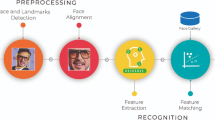Abstract
As a continuation of the work that we had done in the past to develop an automatic attendance system for the campus of our institution, the following is stated—In this study, we will examine the differences in the implementation approaches of a face recognition model on actual mobile devices (iOS and Android), as well as its performance. Specifically, we will look at the discrepancies between these two categories. In particular, we will investigate the ways in which these distinctions influence the precision of face recognition predictions as well as the amount of work that is required of devices in order for them to use a machine learning model, examine the advantages and disadvantages of the model encoding approach that is shared by the TensorFlow and CoreML frameworks, as well as how it helps to the overall success of the AttendanceKit system.





Similar content being viewed by others
References
Tran T-D, Huynh K-T, Nguyen P-Q, Ly T-N. AttendanceKit: a set of role-based mobile applications for automatic attendance checking with UHF RFID using realtime firebase and face recognition. Springer, pp. 432–446 (2022).
Chiem Q-H et al. Attendance monitoring using adjustable power UHF RFID and web-based real-time automated information system. Springer, pp. 392–407 (2021).
Tran M-D, et al. Performance analysis of automatic integrated long-range RFID and webcam system. SN Comput Sci. 2022;3:473.
Google. TensorFlow Document. https://www.tensorflow.org/ [Online; accessed 10 Apr 2023] (2023).
Schroff F, Kalenichenko D, Philbin J. FaceNet: a unified embedding for face recognition and clustering, pp. 815–823 (2015).
Google. TensorFlow Lite Document. https://www.tensorflow.org/lite/ [Online; accessed 10 Apr 2023] (2023).
Adeniran T, Sanni Y, Faruk N, Olawoyin L. Design and implementation of an automated attendance monitoring system for a Nigerian university using RFID (2019).
Anitha G, Devi PS, Sri JV, Priyanka D. Face recognition based attendance system using MTCNN and FaceNet. Zeichen J. 2020;6:189–95.
Hoang V-D, Dang V-D, Nguyen T-T, Tran D-P. A solution based on combination of RFID tags and facial recognition for monitoring systems. IEEE, pp. 384–387 (2018).
Kar N, Debbarma MK, Saha A, Pal DR. Study of implementing automated attendance system using face recognition technique. Int J Comput Commun Eng. 2012;1:100–3.
Hossain IA, Hossain I, Banik M, Alam A. IoT based autonomous class attendance system using non-biometric identification. IEEE, pp. 268–271 (2018).
Apple. CoreML Document. https://developer.apple.com/documentation/coreml/ [Online; accessed 10 Apr 2023] (2023).
Karthikeyan N. Machine learning projects for mobile applications: build android and IOS applications using tensorflow lite and core ML. Packt Publishing Ltd (2018).
Apple. coremltools Document. https://pypi.org/project/coremltools/ [Online; accessed 10 Apr 2023] (2023).
Marques O. Image processing and computer vision in iOS. New York: Springer; 2020.
Apple. Create ML Document. https://developer.apple.com/machinelearning/create-ml/ [Online; accessed 10 Apr 2023] (2023).
Thakkar M, Thakkar M. Introduction to core ML framework. Beginning machine learning in iOS: CoreML framework, pp. 15–49 (2019).
Thakkar M, Thakkar M. Custom core ml models using create ML. Beginning machine learning in iOS: CoreML framework, pp. 95–138 (2019).
Apple. TuriCreate Document. https://github.com/apple/turicreate/. [Online; accessed 10 Apr 2023] (2023).
Chen Z et al. An empirical study on deployment faults of deep learning based mobile applications. IEEE, pp. 674–685 (2021).
Author information
Authors and Affiliations
Corresponding author
Ethics declarations
Conflict of interest
The authors declare that they have no conflict of interest.
Additional information
Publisher's Note
Springer Nature remains neutral with regard to jurisdictional claims in published maps and institutional affiliations.
This article is part of the topical collection “Future Data and Security Engineering 2022” guest edited by Tran Khanh Dang.
Rights and permissions
Springer Nature or its licensor (e.g. a society or other partner) holds exclusive rights to this article under a publishing agreement with the author(s) or other rightsholder(s); author self-archiving of the accepted manuscript version of this article is solely governed by the terms of such publishing agreement and applicable law.
About this article
Cite this article
Tran, TD., Ly, TN. To Wrap, or Not to Wrap: Examining the Distinctions Between Model Implementations of Face Recognition on Mobile Devices in an Automatic Attendance System. SN COMPUT. SCI. 4, 729 (2023). https://doi.org/10.1007/s42979-023-02185-2
Received:
Accepted:
Published:
DOI: https://doi.org/10.1007/s42979-023-02185-2




